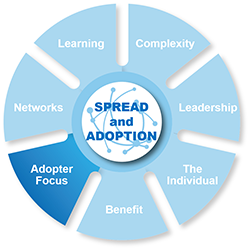Adopter focus
Content
- Increase focus on role of adopters to energise and spread through commitment and agency
- Applying this principle to practice
Increase focus on role of adopters to energise and spread through commitment and agency
 The way an innovation is developed influences its subsequent adoption, spread and sustainability. Approaches range from open and inclusive to more traditional closed and exclusive.
The way an innovation is developed influences its subsequent adoption, spread and sustainability. Approaches range from open and inclusive to more traditional closed and exclusive.
Involving a wide range of people [and contexts] in the innovation development process maximises spread. Actively involve patients and carers as they can successfully innovate and facilitate spread of innovation e.g. Digibete.
Early involvement of adopters in the development process increases commitment and ownership by developing investors rather than buyers of the innovation.
Appreciate involvement too early may be in an innovation which does not deliver but involvement that is too late may lead to poor adoption and diminished learning opportunities.
A more inclusive approach allows development of a network alongside the innovation. This network can enhance the innovation in both its development and in its acceptance and adoption [case study] and increase 2–way communication between innovators and adopters maximising learning.
Maximise engagement and ownership to energise the adopter community and spread via commitment [Pull] not compliance [Push] harnessing individual and collective agency. See individual principle for more information.
Adaptation is needed for complex innovations with multiple components and relational elements. Local adaptation and creativity is needed to respond to unique settings and may result in substantial refinement. When adapting consider unintended consequences, risk and check back to purpose.
Adaptation increases understanding and confidence, speed of spread, makes the innovation come alive, creates ownership and embeds for sustainability. Therefore, what is needed is an innovation that can be adapted locally rather than a finished, inflexible product.
Use in in different contexts increases understanding of which aspects of the innovation should remain fixed [the core] and which can be adapted to the new setting [flexibility][HP Learning]. Gaining understanding of the innovation’s core and flexible elements, along with their interaction with different contexts, means an adopter can understand how to flex the innovation while remaining faithful to the core.
Knowledge and experience on the ‘what’ and the ‘how’ gained from local adaptation by adopters, involving a wide range of contexts, and shared with innovators and the wider community produces an iterative shared, co-created narrative
Plan for spread considering the innovation and its stage of development, approach and context and consider how the innovation will be sustained.
More information on Adopter focus can be found in further resources.
Applying this principle to practice
Consider these questions which will be of varying relevance depending on your context.
- Who do you need to involve in your work? When do you need to involve them? How do you involve them and what is their role?
- What opportunities are there to be part of developing an innovation?
- How can you utilise a network, connecting innovators and adopters, to help develop innovation or spread it?
- How can the adopter community be energised to create a pull for innovations/change?
- How can you adapt your messages so the adopters find them energising?
- What is the level of understanding of complexity and the need for local adaptation and how can this be increased?
- How is learning on local adaption captured and shared?
- How are unintended consequences used to inform learning?
- How does your spread and adoption plan incorporate sustainability?
You may find the following helpful, also see practical tools and methods, further resources and systems convening:
- Stakeholder mapping
- Personas
- Accelerated Design Event (ADE)
- Social media including crowdsourcing and tweet chats
